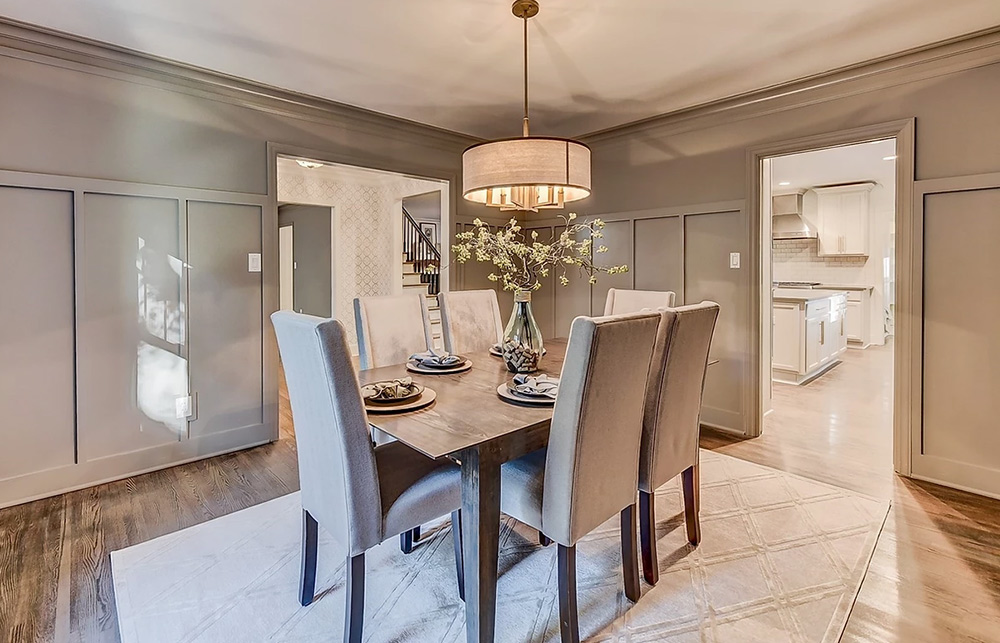在加州中央谷經(jīng)營房地產(chǎn)公司的湯姆?麥克唐納說:“我干這行已經(jīng)47年了,,剛?cè)胄心菚r所謂的電子化事務(wù),,就是通過電報接收合同?!?
而最近幾個月,,同大多數(shù)房地產(chǎn)經(jīng)紀人一樣,他的業(yè)務(wù)比以往任何時候都更加依賴于科技,。原因是美國各地為應(yīng)對疫情采取了一系列限制措施,,加州也全面禁止傳統(tǒng)的房屋開放日。
少了餅干香甜氣息的加持和與陌生人的互動,,麥克唐納和其他房地產(chǎn)經(jīng)紀人轉(zhuǎn)而尋求能夠幫助其在線上展示房源的新工具,。與幾年前相比,新工具的應(yīng)用大大提升了客戶體驗感,,讓房地產(chǎn)經(jīng)紀人可以更好地向潛在購買者展示房源,,而且整個過程是既簡單又經(jīng)濟。
virtual staging應(yīng)用就是其中之一,,它是通過三維建模和 Photoshop軟件將造型逼真的家居裝飾通過數(shù)字化手段添加到待售房屋圖片中,,形成預(yù)覽。同時不斷增加還有基于成熟虛擬現(xiàn)實技術(shù)的各種虛擬漫游,。雖然許多謹慎的買家仍希望在簽約前親自看看房子,,但是房地產(chǎn)經(jīng)紀人和企業(yè)家們都認為,后疫情時代,,這些新的營銷工具仍有其一席之地,。
溫哥華公司Bella Staging的聯(lián)合創(chuàng)始人金英表示:“封鎖期間,由于房屋開放日活動和傳統(tǒng)的房屋售前裝飾公司都處于停擺狀態(tài),,我們實際上比以前更忙了,。”
Bella是一家專注于虛擬裝飾業(yè)務(wù)的公司,。通常房屋在準備出售前都會臨時裝修一番,以吸引潛在購買者,。而虛擬裝飾是這一傳統(tǒng)模式的數(shù)字化形式,。以前的做法是租用家具,雇人搬運和布置,,通常要花費幾千美金,。而Bella的做法是通過數(shù)字手段將模擬家具“擺放”到房屋圖片中以呈現(xiàn)最終效果。根據(jù)金的說法,,只需要不到100美金,,他的設(shè)計師和圖片編輯團隊就可以設(shè)計一套房屋的虛擬裝修方案。

不過這樣做偶然也會讓客戶產(chǎn)生誤解?!坝泻脦状?,我們的客戶收到房產(chǎn)報價,買家希望這些家具(虛擬的)也包括在內(nèi),?!苯鹫f,大多數(shù)情況下,,客戶明白這只是展示效果,。“我們只是幫助人們描繪出房屋裝飾后可能的樣子,?!?
另一個使用激增的數(shù)字工具是虛擬漫游,它能給買家?guī)砀由砼R其境的感受,。在高端市場,,使用三維建模渲染技術(shù)可以構(gòu)建成熟的虛擬現(xiàn)實體驗。但是更常見的(同時也是可以負擔(dān)的)是使用360度全景照片制作的虛擬漫游,。
巴泰克?德羅茲是Kuula公司聯(lián)合創(chuàng)始人,,他說:“房屋有多大?布局如何?這些都能通過虛擬漫游感受得一清二楚,?!?德羅茲將其核心產(chǎn)品形容為“就像虛擬參觀的幻燈片”。用戶自己拍攝照片,,然后使用Kuula 軟件對這些照片進行處理,,創(chuàng)造令人沉浸其中的家庭參觀體驗。(缺點是使用該軟件只展示房屋的實際情況,,不支持添加虛擬裝飾,。)
德羅茲說,特殊時期,,人們對虛擬看房的興趣和相應(yīng)的網(wǎng)絡(luò)流量都有顯著提升,。實際上,在前幾年,,Kuula一直保持著穩(wěn)步增長,。德羅茲認為停工加速了房屋購買方式的轉(zhuǎn)變,而且這種轉(zhuǎn)變將長期存在,,并非只是短期變化,。判斷依據(jù)源于一個簡單的事實: 即使在正常時期,開放參觀房屋也不是促成買家購買的有效方式。
德羅茲說: “在交通擁堵的洛杉磯,,開車一小時,,看房一分鐘,然后你發(fā)現(xiàn)這個房子不是你想要的,?!笔嗄陙恚T如Zillow 這樣的網(wǎng)站持續(xù)將更多的房屋購買手續(xù)轉(zhuǎn)移到線上辦理,,而沉浸式體驗則將線上業(yè)務(wù)直接帶入了新時代,。
麥克唐納對此表示贊同,他說:“我認為,,這將長期改變房屋的銷售模式,。人們越來越習(xí)慣于坐在自家客廳,用蘋果電視瀏覽房源信息,?!丙溈颂萍{表示,大多數(shù)購房者在決定購買前都想實地看看自己的新家,,但對于那些跨地域,,從未踏足過房屋的搶購者來說,新工具的使用增添了他們的購買信心,。
部分得益于這些數(shù)字工具(同時也得益于破紀錄的低抵押貸款利率) ,,整個疫情期間,房地產(chǎn)業(yè)務(wù)似乎一直表現(xiàn)良好,。根據(jù)全美房地產(chǎn)經(jīng)紀人協(xié)會的數(shù)據(jù),,今年五月房地產(chǎn)合同簽訂量同比僅下降了5.1% 。與經(jīng)濟領(lǐng)域中的許多行業(yè)相比,,這只是一個小幅度的下滑,。
事實上,由于供應(yīng)緊張,,美國房價在最近幾個月普遍上漲,。盡管居家令凸顯了人們目前居住房屋的設(shè)計缺陷,但考慮到失業(yè)情況和經(jīng)濟的不確定性,,對于一些人來說購買新房并非易事,。
在線家居設(shè)計社區(qū) Houzz 的視覺技術(shù)總監(jiān)黃莎莉(音)說:“疫情期間,幾乎每個人都意識到自己房屋的空間設(shè)計不合理,。”該網(wǎng)站提供名為“看看我的房間”在線可視化工具,,購買者可以通過這個工具虛擬地查看家具的樣式與尺寸是否適用于自己的居住空間,。
如果你想擁有心儀的房子,無論是正在尋找,還是嘗試將現(xiàn)有居所變得更加稱心如意?,F(xiàn)在,,能夠做的事情比以往任何時候都多。(財富中文網(wǎng))
譯者:Feb
在加州中央谷經(jīng)營房地產(chǎn)公司的湯姆?麥克唐納說:“我干這行已經(jīng)47年了,,剛?cè)胄心菚r所謂的電子化事務(wù),,就是通過電報接收合同?!?
而最近幾個月,,同大多數(shù)房地產(chǎn)經(jīng)紀人一樣,他的業(yè)務(wù)比以往任何時候都更加依賴于科技,。原因是美國各地為應(yīng)對疫情采取了一系列限制措施,,加州也全面禁止傳統(tǒng)的房屋開放日。
少了餅干香甜氣息的加持和與陌生人的互動,,麥克唐納和其他房地產(chǎn)經(jīng)紀人轉(zhuǎn)而尋求能夠幫助其在線上展示房源的新工具,。與幾年前相比,新工具的應(yīng)用大大提升了客戶體驗感,,讓房地產(chǎn)經(jīng)紀人可以更好地向潛在購買者展示房源,,而且整個過程是既簡單又經(jīng)濟。
virtual staging應(yīng)用就是其中之一,,它是通過三維建模和 Photoshop軟件將造型逼真的家居裝飾通過數(shù)字化手段添加到待售房屋圖片中,,形成預(yù)覽。同時不斷增加還有基于成熟虛擬現(xiàn)實技術(shù)的各種虛擬漫游,。雖然許多謹慎的買家仍希望在簽約前親自看看房子,,但是房地產(chǎn)經(jīng)紀人和企業(yè)家們都認為,后疫情時代,,這些新的營銷工具仍有其一席之地,。
溫哥華公司Bella Staging的聯(lián)合創(chuàng)始人金英表示:“封鎖期間,由于房屋開放日活動和傳統(tǒng)的房屋售前裝飾公司都處于停擺狀態(tài),,我們實際上比以前更忙了,。”
Bella是一家專注于虛擬裝飾業(yè)務(wù)的公司,。通常房屋在準備出售前都會臨時裝修一番,,以吸引潛在購買者。而虛擬裝飾是這一傳統(tǒng)模式的數(shù)字化形式,。以前的做法是租用家具,,雇人搬運和布置,通常要花費幾千美金,。而Bella的做法是通過數(shù)字手段將模擬家具“擺放”到房屋圖片中以呈現(xiàn)最終效果,。根據(jù)金的說法,,只需要不到100美金,他的設(shè)計師和圖片編輯團隊就可以設(shè)計一套房屋的虛擬裝修方案,。
不過這樣做偶然也會讓客戶產(chǎn)生誤解,。“有好幾次,,我們的客戶收到房產(chǎn)報價,,買家希望這些家具(虛擬的)也包括在內(nèi)?!苯鹫f,,大多數(shù)情況下,客戶明白這只是展示效果,?!拔覀冎皇菐椭藗兠枥L出房屋裝飾后可能的樣子?!?
另一個使用激增的數(shù)字工具是虛擬漫游,,它能給買家?guī)砀由砼R其境的感受。在高端市場,,使用三維建模渲染技術(shù)可以構(gòu)建成熟的虛擬現(xiàn)實體驗,。但是更常見的(同時也是可以負擔(dān)的)是使用360度全景照片制作的虛擬漫游。
巴泰克?德羅茲是Kuula公司聯(lián)合創(chuàng)始人,,他說:“房屋有多大,?布局如何?這些都能通過虛擬漫游感受得一清二楚?!?德羅茲將其核心產(chǎn)品形容為“就像虛擬參觀的幻燈片”,。用戶自己拍攝照片,然后使用Kuula 軟件對這些照片進行處理,,創(chuàng)造令人沉浸其中的家庭參觀體驗,。(缺點是使用該軟件只展示房屋的實際情況,不支持添加虛擬裝飾,。)
德羅茲說,,特殊時期,人們對虛擬看房的興趣和相應(yīng)的網(wǎng)絡(luò)流量都有顯著提升,。實際上,,在前幾年,Kuula一直保持著穩(wěn)步增長,。德羅茲認為停工加速了房屋購買方式的轉(zhuǎn)變,,而且這種轉(zhuǎn)變將長期存在,并非只是短期變化,。判斷依據(jù)源于一個簡單的事實: 即使在正常時期,,開放參觀房屋也不是促成買家購買的有效方式,。
德羅茲說: “在交通擁堵的洛杉磯,開車一小時,,看房一分鐘,然后你發(fā)現(xiàn)這個房子不是你想要的,?!笔嗄陙恚T如Zillow 這樣的網(wǎng)站持續(xù)將更多的房屋購買手續(xù)轉(zhuǎn)移到線上辦理,,而沉浸式體驗則將線上業(yè)務(wù)直接帶入了新時代,。
麥克唐納對此表示贊同,他說:“我認為,,這將長期改變房屋的銷售模式,。人們越來越習(xí)慣于坐在自家客廳,用蘋果電視瀏覽房源信息,?!丙溈颂萍{表示,大多數(shù)購房者在決定購買前都想實地看看自己的新家,,但對于那些跨地域,,從未踏足過房屋的搶購者來說,新工具的使用增添了他們的購買信心,。
部分得益于這些數(shù)字工具(同時也得益于破紀錄的低抵押貸款利率) ,,整個疫情期間,房地產(chǎn)業(yè)務(wù)似乎一直表現(xiàn)良好,。根據(jù)全美房地產(chǎn)經(jīng)紀人協(xié)會的數(shù)據(jù),,今年五月房地產(chǎn)合同簽訂量同比僅下降了5.1% 。與經(jīng)濟領(lǐng)域中的許多行業(yè)相比,,這只是一個小幅度的下滑,。
事實上,由于供應(yīng)緊張,,美國房價在最近幾個月普遍上漲,。盡管居家令凸顯了人們目前居住房屋的設(shè)計缺陷,但考慮到失業(yè)情況和經(jīng)濟的不確定性,,對于一些人來說購買新房并非易事,。
在線家居設(shè)計社區(qū) Houzz 的視覺技術(shù)總監(jiān)黃莎莉(音)說:“疫情期間,幾乎每個人都意識到自己房屋的空間設(shè)計不合理,?!痹摼W(wǎng)站提供名為“看看我的房間”在線可視化工具,購買者可以通過這個工具虛擬地查看家具的樣式與尺寸是否適用于自己的居住空間,。
如果你想擁有心儀的房子,,無論是正在尋找,,還是嘗試將現(xiàn)有居所變得更加稱心如意。現(xiàn)在,,能夠做的事情比以往任何時候都多,。(財富中文網(wǎng))
譯者:Feb
“I’ve been doing this for 47 years,” says Tom MacDonald. “I started when something electronic was the acceptance of a contract with a telegram.”
MacDonald heads up his own realty group in California’s Central Valley, and like most realtors, his business in recent months is depending on technology more than ever before. Jurisdictions across the U.S. have responded to the coronavirus with an array of restrictions, including a total ban on traditional open houses in California.
So in the absence of baked-cookie scents and mingling strangers, MacDonald and other realtors are turning to tools that help them show off houses online. This allows for more immersion than was possible just a few years ago, and makes it easier and less expensive for realtors to put a property’s best foot forward.
These new tools include so-called “virtual staging,” in which images of a property have lifelike decor added to them digitally using 3D modeling and Photoshop. They also increasingly include digital walkthroughs of various kinds, verging on full-blown virtual reality. And while many serious buyers still want to see the property in person before signing on the dotted line, realtors and entrepreneurs believe the new marketing tools will stick around well after coronavirus pandemic is under control.
“Because a lot of open houses and conventional staging companies were not operational during the lockdown ... we were actually busier,” says Young Kim, cofounder of Vancouver-based Bella Staging.
Bella specializes in virtual staging, the digital evolution of the common practice of temporarily redecorating a house to impress potential buyers. But instead of renting real furniture and hiring movers to haul it in, which can cost into the thousands of dollars, Bella adds furniture to photos of an empty house using digital wizardry. According to Kim, his team of designers and photo editors can virtually stage an entire house for under $100.
That occasionally leads to confusion. “There’ve been times our clients have had offers on a property, and the buyers wanted the [virtual] furniture included,” says Kim—but for the most part, clients understand that virtual staging is an exercise of imagination. “We help paint the picture of what it can be.”
Another digital tool that has seen a surge in relevance is the virtual walkthrough, which gives potential buyers a more immersive sense of the space. At the very high end, those can be built as full-blown virtual reality experiences using a 3D-rendered simulation. But more common (and affordable) are walkthroughs created using 360-degree photos.
“It gives you a feel for the place. How big it is, what’s the layout,” says Bartek Drozdz, cofounder of Kuula, whose core product he describes as “l(fā)ike Powerpoint for virtual tours.” Users take their own photos, then use Kuula to arrange them into an immersive home-tour experience. (One downside is that Kuula doesn’t allow for the addition of virtual decor, instead capturing a house's real-life appearance.)
Drozdz says he’s seen a significant uptick in interest and web traffic during the pandemic. But growth at Kuula was steady for years before the coronavirus hit, and Drozdz sees lockdowns as accelerating a longterm change in homebuying, rather than a temporary shift. That’s because of a simple reality: even in normal times, open houses aren’t always an efficient way to shop for a home.
“In L.A., with the traffic, you have to drive for an hour to see a house you don’t like the moment you walk in,” says Drozdz. While sites like Zillow have been shifting more of the homebuying process online for well over a decade, immersive experiences take that to the next level.
MacDonald agrees: “I think this will change longterm how homes are sold. People are becoming very comfortable with sitting in their living room, using their Apple TV to look at real estate.” MacDonald says most shoppers do still want to see their new home in person before committing to a purchase, but the new tools give added confidence to some, such as cross-country movers, who snap up properties without ever setting foot in them.
Thanks in part to these digital tools (but also a lot of help from record-low mortgage rates), the real estate business overall appears to be holding up during the pandemic. In May, according to the National Association of Realtors, contract signings were off just 5.1% compared to the year before. That’s a minor drop compared to many sectors of the economy.
In fact, with supplies tight, U.S. home prices have actually gone up on average in recent months. Combined with job losses and economic uncertainty, that might make it tough for some people to buy a new home, even as stay-at-home orders have highlighted the shortcomings of their current one.
“Almost everybody during this pandemic is learning how their space isn’t working for them,” says Sally Huang, who directs visual technologies for online home design community Houzz. The site offers an online visualization tool called “View in my Room” that lets shoppers virtually check the size and style of furniture against their living space.
So whether you’re on the hunt for a new house to love, or trying to love the house you’re in, you can do more of that work online than ever before.






